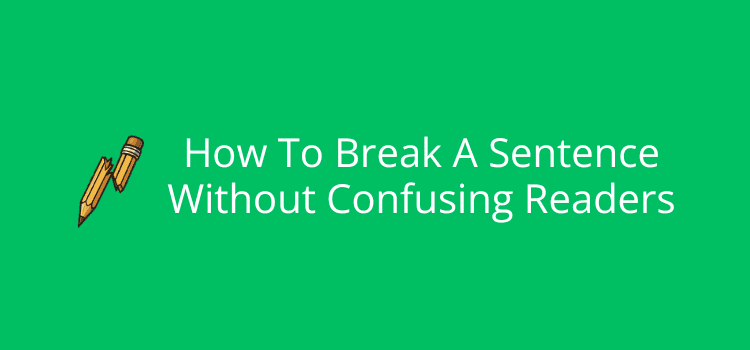
Learning how to break a sentence on purpose is one of the easiest ways to make your writing more interesting.
But breaking sentences is not about making mistakes or not following grammar rules.
It’s a deliberate technique that you can use to add emphasis, create rhythm, or bring more variety to your writing.
It doesn’t matter if you’re writing fiction, nonfiction, blog posts, or articles. You can always vary the construction of your sentences to make your writing more effective.
The purpose of intentional sentence breaks
Breaking a sentence is more than just putting periods (full stops) at the end. It’s a way to help you think about your style, tone, pacing, and emphasis.
When you vary your sentence lengths and structures, it can stop your writing from feeling a bit flat.
You can use short sentences to grab attention, while longer sentences can help with detail or tension.
Using sentence breaks deliberately can also help you highlight key ideas.
A single word or phrase, standing on its own line, can carry much more weight than if it were buried in the middle of a paragraph.
Punctuation also plays a part in sentence structure. Ellipses, colons, semicolons, and em dashes can all create sentence breaks if you use them correctly.
Another use is to copy everyday speech or thought patterns, which can make your writing feel more relatable.
If you want to emphasize contrasts, surprises, or dramatic moments, breaking up a sentence is an ideal way to do it.
The key is to break your sentences intentionally, and for a good reason. But overusing fragments or unusual punctuation can make reading difficult to follow.
So, how can you do it? Here are fifteen ways you can break a sentence effectively, using a mixture of fragments, structural breaks, and punctuation.
15 Examples of how to break a sentence

Now that you understand how breaking a sentence can help, let’s look at practical examples of how to do it.
Each one has its own use and effect. But you don’t need to use all of them.
However, experimenting with a few might help you add more variety.
1. Use short fragments for emphasis
Short sentence fragments can highlight a word or phrase for extra or dramatic impact.
Carol waited. Alone.
Mark knew the truth. Finally.
2. Split long sentences to improve clarity
Break up long, complicated sentences into smaller ones to make your writing easier to follow.
Before: Julia had planned the trip for months, and every detail was carefully considered.
After: Julia had planned the trip for months. Every detail was carefully considered.
Before: The storm raged outside, but inside the house was warm and dry, and everyone huddled together, waiting.
After: The storm raged outside, but inside the house was warm and dry. Everyone huddled together. Waiting.
3. Breaks in dialogue
Use sentence breaks to make dialogue sound natural and punchy.
“I can’t do this.”
“Then who will?”
“Are you sure?”
“Absolutely.”
4. Use breaks for dramatic pauses
Pauses created by sentence breaks can build tension or suspense.
She wanted to speak. To explain. To fix it. But the words never came.
She tried to stay calm. Calm, calm, calm. But her hands shook anyway.
5. End with a strong word or phrase
A short final sentence can leave a lasting impression.
He thought he understood the truth. He didn’t.
She believed she could hide forever. Until now.
6. Fragments for stylistic or poetic effect
Sentence fragments can create rhythm and evoke emotion.
Rain fell. Heavy. Cold. Relentless.
The night was dark. Quiet. Endless.
7. Separate incidental ideas
Break a sentence to emphasize a side thought or reflection.
He agreed to the plan. Which, in hindsight, was a mistake.
I thought I had it all figured out. I was wrong.
8. Copy natural speech
Short fragments mimic real thought or conversation patterns.
“I don’t know. Maybe. It could work.”
“Wait. Are you serious? Really?”
9. Highlight contrasts
Separate contrasting ideas to make the difference clear.
He promised he would return. He never did.
She laughed. He cried.
10. Combine short and long sentences for rhythm
Mixing sentence lengths keeps readers engaged and creates flow.
She ran through the rain. The streets were empty, the city asleep. She smiled.
The lecture dragged on. Endless slides, monotone voice, fading attention. Finally, it ended.
11. Use ellipses for pauses or suspense
Ellipses signal hesitation, trailing thoughts, or suspense.
She opened the envelope… and gasped.
I thought I knew him… but I was wrong.
12. Use colons to emphasize or introduce
Colons can introduce lists, explanations, or dramatic reveals.
He had only one choice: run or stay.
There was only one solution: tell the truth.
13. Use semicolons to connect related ideas
Semicolons join closely related clauses while keeping them distinct.
She wanted to leave early; he wanted to stay late.
The weather was cold; the fire inside kept us warm.
14. Use em dashes to interrupt or add a side thought
Em dashes create emphasis, asides, or interruptions.
He was sure of one thing—he could never forgive her.
I eventually finished the report—after three long days.
15. Break sentences for visual impact in lists or steps
Breaking sentences can make how-to guides and instructional writing easier to follow.
Step one: open the box. Two: remove the contents carefully. Three: inspect each item.
First, gather your materials. Next, prepare your workspace. Finally, begin the project.
Using sentence breaks selectively
As you can see from the examples above, You have are plenty of options to add a break to a sentence without affecting the flow of your writing.
But the real skill is in knowing when to use them. If every paragraph you write is full of fragments, pauses, and dramatic stops, it will start to feel choppy and awkward.
Readers will notice all the breaks instead of your message or story. Look at sentence breaks as spices in cooking: a pinch adds flavor, but too much can ruin the dish.
You can ask yourself these quick questions before breaking a sentence:
Does this break create better emphasis or clarity?
Am I making the rhythm of the sentence stronger?
Will my break choice help a reader feel the mood or tone better?
When you can use sentence breaks for good reason, they are terrific tools for rhythm, emotion, and impact.
Summary
Breaking a sentence up on purpose isn’t about forgetting your grammar rules. It’s about bending them for a good reason.
When you experiment with using short, sharp sentences, fragments, punctuation, and pauses, you can make your writing a little more dynamic.
As with any writing device, the key is balance. Too much will become distracting, but used at the right moment, it can certainly help.
Related Reading: 15 Strong Ways To End A Sentence For More Impact
Share This Article


